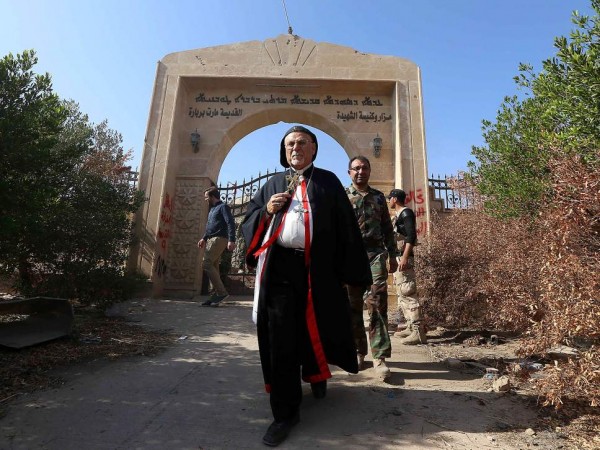
Archbishop Yohanna Petros Mouche of Mosul inspects the damage at the Saint Barbara Church in the town of Qaraqosh ( Getty )
ishtartv.com - independent.co.uk
A little over two years ago, the northern Iraqi town of Qaraqosh lay in ruins. Its churches, shops, houses and farms were mostly destroyed by Isis during its occupation.
Some 50,000 Christian inhabitants of the ancient town fled the terror group’s onslaught when it captured swathes of northern Iraq in 2014. Many feared they would never see their homes again.
Today, around half of that number have returned. Thousands took to the streets last weekend to commemorate Palm Sunday, and more will come out again for Easter.
But the picture for Christians across northern Iraq is less hopeful, with high unemployment, fears over security and a lack of infrastructure stopping many returning.
“Qaraqosh has been one of the most successful in bringing its residents back,” said Faraj Benoit Camurat, president of Fraternity in Iraq, a French organisation that supports Iraq’s religious minorities.
“But overall, it’s a situation of big contrasts. You have towns which seem almost normal like Qaraqosh, and you have
some where things are not so good,” he added.
Qaraqosh is the largest Christian town in Iraq and can trace its Christian identity back to the fourth
century, when Assyrians adopted the new religion and began building monasteries and churches. It was relatively affluent before Isis came along, drawing its wealth from farmlands and trade with the metropolis of Mosul, just 20 miles away.
When Isis captured Mosul in 2014, it sent a chilling warning to Christians in nearby towns and villages, announcing that they must convert, pay a special tax or “face the sword”. The group waged a campaign of violence and murder against other minorities – Yazidis and Shia Muslims suffered greatly too.
More than 100,000 Christians fled their homes in fear of the Isis advance and many of them are still living in displacement camps in Iraqi Kurdistan.
Around 37,000 Christians returned to their homes in the Nineveh plains between 2017 and 2018, according to the Nineveh Reconstruction Committee. But tens of thousands more are still displaced in camps, mostly in Iraqi Kurdistan.
In a recent survey of displaced minorities in Iraq by the United Nations International Organisation for Migration (IOM), Christians were most likely to say they do not plan to return home, with only 22 per cent saying they would go back.
They were also the most likely to say they planned to settle abroad, at 42 per cent. Compared to those numbers, the 25,000 who have returned to Qaraqosh makes it something of a success story.
“Because of its size, it reached a critical number of people coming back, which meant services and infrastructure was relaunched,” said Mr Camurat.
“It was also key that the educational system of Qaraqosh continued to work when they were displaced. Schools are back to normal work very
quickly, because all the structures were still alive.”
The Palm Sunday celebrations last weekend were the largest since the town’s liberation, and they had an added poignancy for many who have returned.
“Seeing the huge number of people of my town all walking and singing hymns together in a procession is
a solid evidence that we are still here, that Christianity in Iraq is not dead, and never will be,” said 24-year-old Fadi Banno.
“For me, it’s a great joy to see this happening again after what happened to us because of Isis,” he told The Independent.
But other towns in the Nineveh plains, which have been home to a Christian community for two millennia, have not been so quick to recover.
In Bartella, around 10 miles down the road from Qaraqosh, fewer than a third of 3,800 Christian families have returned home, according to the Associated Press. Many of them now complain of harassment from Shia militias which now control security in the town.
“There are no jobs here,” one resident, who asked to remain anonymous, told The Independent. “A lot of the homes are still destroyed.”
Iraq’s Christian community has faced instability before. There has been a rapid decline in the Christian population in the country over the last two decades, beginning with the onset of the US invasion in 2003. At that time, there were an estimated 1.4 million Christians in the country. Today, fewer than 300,000 are thought to remain.
The invasion and occupation of Iraq sparked a wave of Islamist militancy in nearby Mosul that led to many Christians fleeing. Many left the country for the US and Europe – as they still doing today.
Open Doors, an organisation that tracks persecution of Christians, said: “The territorial defeat of Isis reduced the level of persecution across the country. However, threats from extremist groups make it difficult for returning Christians to feel safe and secure from acts of Christian persecution.”
The problems affecting Christians are by no means exclusive to the minority. According to the IOM, more than 1.8 million people remain displaced across Iraq five years after the Isis onslaught began.
“Many live in a state of limbo – often working in the informal labour sector, still crowding extended families into small living spaces and relying on funds from family members or government pensions,” the IOM said in February. The same report said a lack of economic opportunities and public services were the main factors in keeping them displaced.
|